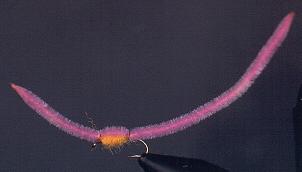Strategies for High, Cloudy Waters
The summer of 2004 seemed like a carbon copy of 2003. From May through August heavy rains fell several times a week throughout much of the Northeast. Floods were the norm. Each week heavy rains inundated different areas in New York, New Jersey, Maryland and Pennsylvania. But the weather shouldnít have mattered to me. It should have been the least of my worries. In early May I broke my arm when I fell off a ladder. It was my left armómy writing arm. The surgeon placed pins in the arm and they became infected. I suffered for much of the summer with excruciating pains. I tied my first flies in early August. And I couldnít fish for three months!
But, that didnít stop me from inviting friends to fish, and I went along as a guide. Many of those trips were almost wasted with the high, cloudy waters we encountered. We probably should have cancelled several of those fishing trips, but because we did fish and we caught trout the valuable lessons we learned under those adverse conditions are worth passing along to you.
When you encounter high, cloudy waters you have got to consider several important strategies. They are selecting the proper pattern, getting the fly to the right depth and deciding where to fish. Letís look at these as essential strategies.
Which pattern would you rather use under these adverse conditions? Would you tie on a Pink Worm, bead head Pheasant tail or a Zebra Midge? I have found under many of these high, cloudy water settings that a pink colored fly works well. Several years ago I wrote an article in the Mid Atlantic Fly Fishing Guide about the Pink Ugly. Ron Germanís wife Flossie first tied that large pink streamer pattern. I still remember the time I handed one of these large streamers to Bob Budd when the stream we fished was high and off color. Bob picked up a half dozen trout in a short time on that pattern.
 But, more recently Fred Bridge of York, Pennsylvania gave me a pattern he calls the Pink Worm. Just a couple weeks ago, under adverse fishing conditions, I handed one of these to Bill Sharpe and his son, Peter. In three hours of fishing under very poor fly-fishing conditions the two caught 15 trout on that Pink Worm. The Pink Worm is nothing more than an orange dubbed body of angora with a piece of bright pink vernille tied over top and extended an inch beyond the eye and the bend of the hook. I use fluorescent red tying thread to secure the vernille at the bend and at the eye. I tie the pattern on a size 12 or 14 wet fly hook. Other large, bright patterns sometimes work under these poor conditions. The Mickey Finn and Royal Coachman streamer have produced for me under similar circumstances in the past. But, more recently Fred Bridge of York, Pennsylvania gave me a pattern he calls the Pink Worm. Just a couple weeks ago, under adverse fishing conditions, I handed one of these to Bill Sharpe and his son, Peter. In three hours of fishing under very poor fly-fishing conditions the two caught 15 trout on that Pink Worm. The Pink Worm is nothing more than an orange dubbed body of angora with a piece of bright pink vernille tied over top and extended an inch beyond the eye and the bend of the hook. I use fluorescent red tying thread to secure the vernille at the bend and at the eye. I tie the pattern on a size 12 or 14 wet fly hook. Other large, bright patterns sometimes work under these poor conditions. The Mickey Finn and Royal Coachman streamer have produced for me under similar circumstances in the past.
Thatís only part of the story, however. Until Bill and Peter got the Pink Worm on or within a few inches of the bottom they caught few trout. How can you accomplish this when you encounter high water conditions? Both Bill and Peter added two light lead shot about six inches above the fly. But, itís is often difficult to cast lead shot and they tend to tangle the leader. Thereís another way to get that pattern deep: I add about 15 wraps of .010 lead to the shank of the hook when Iím tying the fly.
Under these poor conditions how do you follow that wet fly on its drift? Of course some of the more astute anglers just follow the fly fine and look for the least bit of hesitation. But, I donít consider myself a skilled wet fly fisher. Normally I use a dry fly as a strike indicator, but when I fish a heavily weighted wet fly, and with high water, and then I use a large poly strike indicator. That indicator will float under the most adverse conditions.
Where to drift that weighted pink fly is also important. Under a high-water environment trout often seek out backwater and eddies where you would not normally find them. Here they are out of the faster water and able to feed. If those slower areas donít produces any trout then try some of the faster wateróbut keep the fly deep and near the bottom.
So, what will you do this weekend if you encounter high, cloudy waters? Will you sit and wonder how well you could have done with normal waters? Will you fly fish using your regular methods? Or, will you try a pink fly and fish it deep? The choice is up to you. Good fishingóand remember to release those trout. Iíll be watching you.
|